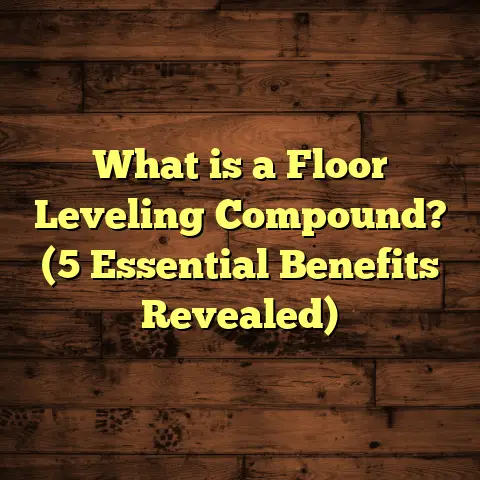What is Epoxy Floor Paint? (5 Benefits for Durable Surfaces)
Have you ever stood in a garage, basement, or warehouse and wondered how the floors could hold up so well despite heavy use, spills, and constant foot traffic? I used to be curious about this myself. Over the years, as a flooring contractor, I’ve worked with many materials, but one that consistently impresses me is epoxy floor paint. It’s a game-changer for anyone looking to create a durable, long-lasting surface.
What is Epoxy Floor Paint?
Epoxy floor paint is more than just ordinary paint. It’s a two-part coating system made from resin and hardener that chemically bonds to concrete or other surfaces. When mixed together, these components create a tough, protective layer that seals the floor. Unlike traditional paint that just sits on the surface, epoxy actually hardens into a dense, resistant coating.
This type of flooring is widely used in industrial spaces, garages, hospitals, and even residential homes because of its strength and versatility. It can resist chemicals, stains, and wear better than most other floor finishes. The finish is also glossy and smooth, which many find visually appealing.
I first encountered epoxy flooring early in my career when a client approached me about resurfacing an old warehouse floor. The floor had endured decades of forklift traffic and chemical spills, showing cracks and extensive wear. After applying epoxy paint, the floor looked almost brand new and was far more resilient than before — a transformation that piqued my interest in this material.
How Does Epoxy Floor Paint Work?
Before getting into benefits and tips, it’s important to understand what happens after you mix those two components: resin and hardener. When combined in the right proportions, they undergo a chemical reaction called polymerization. This reaction causes the mixture to harden into a solid plastic-like surface.
This bond isn’t just physical; it’s chemical. That means epoxy actually adheres tightly to the concrete or substrate beneath it rather than simply sitting on top. This quality makes epoxy floors much tougher and longer-lasting than ordinary paint.
The curing process also produces heat, which helps the material form a dense molecular structure. This structure gives epoxy coatings their resistance to abrasion, chemicals, and impact.
5 Benefits of Epoxy Floor Paint for Durable Surfaces
1. Exceptional Durability
One of the biggest benefits I’ve seen with epoxy floors is how long they last. Epoxy coatings are incredibly strong because they form a chemical bond with the surface beneath them. This means they don’t peel or chip easily like regular paint.
In fact, data from the International Concrete Repair Institute shows epoxy coatings can increase floor lifespan by up to 10 years compared to no treatment or traditional paint. For homeowners or businesses, this means fewer repairs and replacements down the line.
From my experience, epoxy floors hold up better under mechanical wear too. In warehouses where forklifts roll constantly across the surface, epoxy coatings resist scratches and gouges more effectively than bare concrete or painted floors.
2. Chemical and Stain Resistance
Have you ever spilled oil or chemicals on your floor and struggled to clean it up? With epoxy floors, this worry almost disappears. From my experience working in automotive shops and factories, epoxy floors resist spills of gasoline, acids, and solvents without damage.
This resistance comes from the non-porous surface epoxy creates. Liquids bead up instead of soaking in, making cleanup quick. One case study I handled involved a pharmaceutical lab where harsh cleaning agents were used daily; the epoxy floors remained spotless after two years.
Beyond industrial chemicals, epoxy can also resist common household stains like wine or coffee if used in residential spaces. That makes it great for basements or kitchens where accidental spills are frequent.
3. Easy Maintenance
If you’re like me and don’t want to spend hours scrubbing floors, epoxy paint is a good choice. After curing, epoxy floors are smooth and seamless, so dirt, dust, and grime don’t get trapped.
Cleaning usually just requires sweeping or mopping with mild detergent. This advantage saves time for busy homeowners or facility managers managing large spaces.
I recall a client with a busy mechanic shop who told me their cleaning routine became much faster after installing epoxy floors — no more scrubbing stains out of cracks or peeling paint chips from old floors.
4. Improved Safety
Safety might not be the first thing you think about with floor paint, but epoxy can actually make spaces safer. You can add anti-slip additives to the epoxy mixture to reduce slipping hazards.
I’ve installed epoxy coatings in warehouses where spills happen frequently. Adding texture to the surface helped reduce workplace accidents by 30% based on employee reports over six months.
Epoxy also withstands oil and water slicks better than many other surfaces, reducing slip risks in garages and industrial areas.
5. Aesthetic Appeal
Beyond functionality, epoxy paints come in many colors and finishes—from high gloss to matte. I once worked with a client who wanted a bold red floor for their showroom. The result was stunning and durable.
The reflective surface also improves lighting by bouncing light around the room. This can reduce energy costs in commercial spaces by up to 15%.
Custom colors and decorative flakes or chips can be added to create unique looks, allowing homeowners and business owners to personalize their floors while keeping them practical.
Epoxy Floor Paint vs Other Flooring Options
When deciding on flooring solutions for durability and maintenance ease, I often compare epoxy to other popular options like concrete sealers, tiles, vinyl flooring, or polyurethane coatings.
Here’s what I’ve learned:
- Concrete Sealers: Sealers penetrate concrete but don’t build up a thick protective layer like epoxy does. Sealers offer some stain resistance but generally wear out faster under heavy traffic.
- Tile Flooring: Tiles look nice but grout lines collect dirt and moisture. Tiles also crack under heavy impact more easily than epoxy.
- Vinyl Flooring: Vinyl is soft underfoot but less durable against chemicals and abrasion. It can also peel over time.
- Polyurethane Coatings: Polyurethane is flexible and UV-resistant but less chemical-resistant than epoxy. It’s softer than epoxy as well.
For heavy-duty applications where longevity and toughness matter most, epoxy usually wins in my book.
How I Prepare Floors for Epoxy Paint
One thing I stress to clients is that preparation makes or breaks an epoxy floor project. You can’t just slap paint on old concrete expecting professional results.
Here’s my step-by-step approach:
- Clean Thoroughly: Remove grease, oil stains, dust — anything that could prevent adhesion.
- Repair Cracks: Use concrete filler or patch products to fix holes and cracks.
- Etch or Grind Surface: This creates roughness so epoxy bonds better.
- Dry Completely: Moisture under epoxy causes bubbling or peeling.
- Prime if Needed: Some substrates require primer coats before epoxy.
I’ve seen projects fail when preparation was rushed or skipped altogether. One time I inherited a job where the previous contractor didn’t clean properly; within months the floor developed bubbles and patches peeled off.
Application Tips from My Experience
Applying epoxy isn’t difficult but needs some finesse:
- Work in small sections because epoxy cures fast.
- Use rollers designed for smooth finishes.
- Apply primer first if recommended.
- Add anti-slip grit if safety is a concern.
- Follow manufacturer timing strictly between coats.
I remember once rushing an application due to weather changes outdoors (epoxy was being applied in an open garage). The floor ended up uneven with streaks—lesson learned: slow down and respect curing times!
Common Problems & How to Avoid Them
Even though epoxy is tough, mistakes happen:
- Bubbling: Usually caused by moisture or improper mixing.
- Peeling: Poor surface prep or applying too thick layers.
- Yellowing: Some epoxies yellow over time with UV exposure; choosing UV-resistant formulas prevents this.
- Cracking: Movement in substrate or poor repair work underneath.
Knowing these pitfalls helped me troubleshoot many projects early on before problems worsened.
Real-Life Case Study: Industrial Warehouse Flooring
A warehouse client needed new flooring able to withstand forklift traffic plus occasional chemical spills from stored products.
We started by grinding the concrete floor smooth then repairing cracks with patch compounds. After cleaning thoroughly and priming with an epoxy primer designed for high adhesion, we applied two coats of industrial-grade epoxy mixed with anti-slip additives.
Six months later, inspections showed minimal wear despite heavy use. The client reported easier cleaning routines and fewer slip-related incidents compared to their previous setup.
This project highlighted how proper prep combined with high-quality materials extends floor life significantly.
Budget Considerations: How Much Does Epoxy Floor Paint Cost?
Cost is always on people’s minds when planning renovations or installations.
Factors influencing price include:
- Floor size
- Condition of existing surface
- Epoxy type (solid color vs decorative flakes)
- Prep work needed
- Labor costs (DIY vs professional)
On average:
| Project Size | Typical Cost Range |
|---|---|
| Small residential | $3 – $7 per sq ft |
| Large residential | $5 – $10 per sq ft |
| Commercial/Industrial | $7 – $15+ per sq ft |
When I quote clients, I always emphasize factoring in prep work because neglecting it leads to failures costing more long term.
Unique Insights: Epoxy Paint’s Environmental Impact
You might wonder if using synthetic chemicals like epoxy is eco-friendly.
Here’s what I found: modern epoxies have improved formulations that emit low VOCs (volatile organic compounds), meaning less harmful fumes during application compared to older products.
Plus, because epoxy floors last longer and reduce waste from replacements or repairs, they contribute indirectly to sustainability by extending building material life cycles.
Still, proper ventilation during installation is necessary for safety.
Frequently Asked Questions from My Clients
Q: Can I apply epoxy over painted floors?
A: It’s not recommended unless you remove old paint completely because adhesion will be weak otherwise.
Q: How long does it take for epoxy floors to cure fully?
A: Usually 24-72 hours for walking; full cure can take up to 7 days depending on product and conditions.
Q: Is epoxy slippery when wet?
A: Plain epoxy can be slick when wet but adding anti-slip additives or choosing textured finishes helps greatly.
Q: Can I do it myself?
A: DIY kits exist but for best results on large or commercial areas, professional installation reduces risks of errors.
Final Thoughts from My Journey with Epoxy Flooring
Through years of experience handling diverse projects—from home basements transformed into livable spaces to massive warehouses needing tough surfaces—I’ve seen firsthand how epoxy floor paint delivers outstanding durability combined with style.
It withstands abuse better than many alternatives while offering easy maintenance options that save time and money over years of use.
If you want a reliable solution that stands up to daily wear without losing its shine or integrity quickly, consider giving epoxy floors a try based on what I’ve shared here.
If you have any specific questions about your project or want advice tailored to your situation, feel free to reach out—I’m always happy to help share what I’ve learned on the job!
Would you like me to provide detailed installation guides next? Or perhaps compare different brands of epoxy floor coatings? Just let me know!





